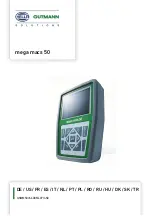
Electrosurgical Unit Minicutter
Revision 08
23
5.2
Patient Placement
Risk of burns from stray currents!
Electrosurgical devices are high-frequency generators designed to create high voltages and currents.
The risk of burns is particularly high where high-power monopolar cutting and contact coagulation
currents are used, while it is very low in purely bipolar application. This is why bipolar technology should
be the method of choice. In order to prevent formation of shunts for HF energy or concentrated leakage
current paths, it is mandatory to comply with the following instructions when placing the patient on the
operating table:
•
The patient must be placed isolated from grounded metal parts. Particular care is required to ensure
that the patient's limbs do not touch any metal structures either.
•
Ensure the required high-frequency insulation against the operating table by a sufficient number of layers
(insulating blankets). Since during the operation moisture, perspiration, etc. are to be expected, a waterproof
foil must be used to prevent wetting of these layers which serve as high-frequency insulation.
•
Fluid accumulation under the patient must be avoided under all circumstances. Use further dry cloth
layers where appropriate.
•
Keep areas with stronger perspiration, extremities touching the trunk or skin-on-skin contact apart
from each other and dry (arm-trunk, leg-leg, breasts) using insulating blankets.
•
Place the neutral electrode as close as possible to the operation field. For operation fields on the
trunk, the upper arms and thighs are good placement positions.
•
The above requirements for insulation must also be fulfilled if the patient is repositioned during the
operation.
5.3
Application of the Neutral Electrode
Danger of burns from missing warning signal in case of one-piece neutral electrodes!
A one-part neutral electrode cannot be monitored. In case of insufficient contact, there will be no warning
signal! The control of the HF output power can be limited for some monopolar cutting currents by one-
piece, large-area neutral electrodes that do not come into direct contact with the patient's skin (so-called
capacitive neutral electrodes). This can lead to the full power being emitted to the patient.
•
We therefore generally recommend using a two-piece disposable neutral electrode that ensures the
continuous monitoring of the patient.
•
If a monopolar HF current is to be used, then a neutral electrode must be placed on the patient.
Also in cases where bipolar application is intended but additional application of monopolar electricity
is likely in case of complications, a neutral electrode should at least be kept ready.
•
The neutral electrode must be securely attached with its entire surface to a suitable and prepared
place on the patient's body.
•
Observe the Instructions for Use of the neutral electrode!
















































